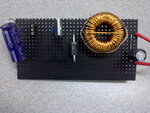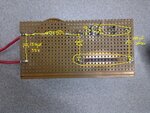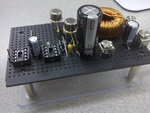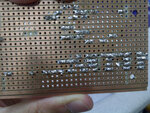gdylp2004
Member level 5
Hello everyone,
I've changed my IRF640NPbF nMOS into IRFB4227PbF and adding a 200V 100uF bypass cap decoupling the +HV 100V (see attached schematic).
Upon turning on my HV 100V PSU, the stripboard suddenly smokes and an awful smell is given off. Went to check what's wrong and realised there is an interesting distinct path that was burnt (see buck_on_stripboard_back.jpg). The components facing side photo is also uploaded (see buck_on_stripboard_face.jpg).
From my guess, when I've turned on the 100V PSU, a surge travels down starting from the MOSFET's drain, 100uF supply bypass cap, schottky (FW) diode and to somewhere else.
The schottky diode was found to be damaged. The burnt marked also ends at the anode of the schottky. But what I did not understand is why didn't the current continue to flow pass the anode of the FW diode and all way to GND, but instead through the diode.
I've changed my IRF640NPbF nMOS into IRFB4227PbF and adding a 200V 100uF bypass cap decoupling the +HV 100V (see attached schematic).
Upon turning on my HV 100V PSU, the stripboard suddenly smokes and an awful smell is given off. Went to check what's wrong and realised there is an interesting distinct path that was burnt (see buck_on_stripboard_back.jpg). The components facing side photo is also uploaded (see buck_on_stripboard_face.jpg).
From my guess, when I've turned on the 100V PSU, a surge travels down starting from the MOSFET's drain, 100uF supply bypass cap, schottky (FW) diode and to somewhere else.
The schottky diode was found to be damaged. The burnt marked also ends at the anode of the schottky. But what I did not understand is why didn't the current continue to flow pass the anode of the FW diode and all way to GND, but instead through the diode.







